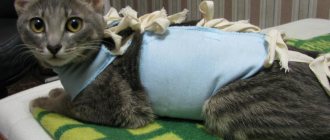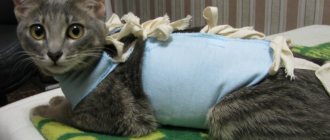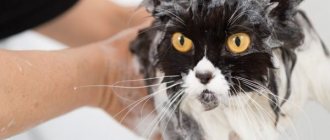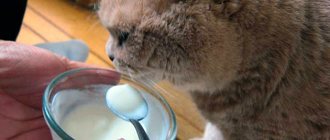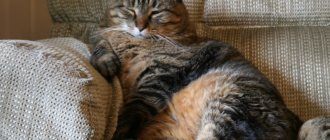May 19, 2020
Castration is a surgical procedure during which a veterinarian removes the testes from a cat. However, this procedure can be performed without surgery.
To understand all the intricacies, you need to learn more about the types of procedures and methods of implementation.
Should a cat be neutered? Pros and cons of the operation
Pet owners think about the sterilization procedure after young cats begin to mark their territory. The main advantage of castration is the disappearance of the desire to mate. However, the operation has many other advantages:
- Elimination of aggressive, restless behavior. The testes produce special hormones that force the cat to look for females and defend its territory from strangers. Even if the animal lives in an apartment and has never seen other cats, the owners may notice the pet’s constant anxiety. If two males meet in the same territory, fights will begin. Excessive testosterone production can lead to the cat attacking its owners.
- Prevention of diseases. After castration, a cat will not develop a testicular tumor, since this organ will be completely removed.
- Reducing the risk of the animal running away. Even if a cat is very attached to its owners, the natural instinct of reproduction can take precedence over reason. The animal will try to escape every time it smells a female. Domestic cats are poorly adapted to outdoor life. After castration, the animal is unlikely to want to leave a comfortable and safe place.
- Elimination of unpleasant odors. Kittens' urine does not have a strong odor. During a cat's puberty, a special secretion is mixed into the urine. Hormones force the male to “mark” his territory and attract females. People find this scent very unpleasant. After castration, the cat's urine will not have a strong odor. The pet will only go to the litter box and not mark any surfaces in the house.
- Increased life expectancy. According to worldwide statistics, neutered pets live longer. They do not experience stress from heat. This makes their nervous system calmer.
Castration, like any other surgical operation, has its drawbacks. It has been proven that castrated cats become passive. Lack of activity leads to obesity, which in turn contributes to the development of diabetes, urocystitis and urolithiasis, and also provokes joint problems.
Fortunately, most unpleasant complications can be prevented by providing the animal with proper nutrition. In any case, the benefits of castration outweigh any possible disadvantages. The main thing is to entrust the health of the animal to an experienced veterinarian.
Wound care
In summer, the chances of catching a dangerous infection are much higher, since warmth is a haven for bacteria. To avoid infection of your pet in the summer, he needs to undergo a 5-day course of antibiotic treatment.
It is also necessary to purchase a special collar for the cat that prevents the animal from licking itself. It would seem that licking wounds is characteristic of animals and usually helps them. But not in case of castration. A hard cat's tongue can remove stitches and introduce infection into the wound.
The suture area can be treated with hydrogen peroxide, brilliant green or Levomekol ointment. Every morning and evening, check the cat's groin area and check for bleeding or other suspicious phenomena.
When should a cat be neutered?
There are no strict deadlines for castration of cats. Most specialists do not perform surgery on kittens under four months of age. Optimal time for surgery: 6-9 months.
Castration of a cat at an early age
Veterinarians do not recommend sterilization for cats under six months of age. But if the cat shows signs of sexual activity earlier, then castration will be carried out immediately after the animal reaches five months of age.
Surgeries at an early age will not affect weight loss or skeletal underdevelopment. These features are laid down in the genotype, which determines the constitution of the pet.
Carrying out surgery at the age of 7-9 months
It has been proven that cats that have reached the age of 6-9 months tolerate castration best. The animal enters adolescence and begins to show interest in females. The cat may start meowing throughout the day. It is at this age that a pet experiences a hormonal surge, which is negatively reflected in the smell of urine.
The cat also gains sufficient body weight to tolerate anesthesia normally. Some veterinarians advise bringing your cat for surgery long before physiological changes develop.
Carrying out surgery in adulthood
Young cats under 3 years of age tolerate castration quite well. However, it is worth considering that adult males who are already accustomed to marking territory can continue to do so even after castration. It will take at least a month to level out your hormonal levels.
About 5% of animals will continue to mark territory for the rest of their lives. Also, some castrated “untied” cats may try to have sexual intercourse with a female. Veterinarians consider this behavior to be a habit: the cat is simply repeating already established patterns.
Technically, cats over 3 years old can also be neutered. However, in adult animals the risks of anesthesia increase. Such an animal must first be examined: undergo blood tests and undergo a screening ultrasound of the heart.
The most popular and recommended cat food brands
Sterilization radically changes the life of a pet and its habits. If earlier your cat urgently demanded a walk and was looking for a cat, now he is only interested in food. A cat that eats excessively high-calorie foods will begin to gain weight, and this is already a bad sign for the animal. To keep his figure normal, choose the right food!
The range of cat products includes two main types of food: dry and wet. They differ in composition and cost. If the owner chooses the first option, it is necessary to provide the animal with constant access to drinking water.
Which food is better, dry or wet, is up to you to decide; there is no clear answer to this question. The main thing is to choose a fresh composition of proven quality with mandatory certification, giving preference to reliable brands. Experts do not recommend choosing budget food. Such savings can negatively affect the health of the animal.
Premium class food
Experienced breeders recommend giving preference to the following brands:
- Hills – a large assortment of therapeutic and prophylactic products that help prevent obesity in animals;
- Royal Canin - nutritional composition rich in vitamins;
- Purina PRO PLAN is a balanced food with pribiotics that improve intestinal function.
Preparing a cat for castration
The most important rule for the owner: remain calm throughout the entire period of preparation for the operation. Pets understand human emotions very well. The pet will feel anxious and begin to hide and behave aggressively. It is necessary to maintain a fasting diet for 6-8 hours before anesthesia. Water can and even should be left available.
If castration will be carried out by a veterinarian who has not previously examined the cat, it is necessary to prepare information about vaccinations, medications and diseases that the animal has suffered. The owner will also be asked to sign a consent form for the use of anesthesia, an information sheet regarding possible complications after the operation.
Anesthesia for castration of a cat
To choose the optimal method of pain relief, the veterinarian will examine the cat and take measurements of vital signs:
- temperature;
- heart rate;
- blood pressure.
The veterinarian will perform surgery only if he receives confirmation that the cat is healthy enough to recover from anesthesia.
Most often, the animal is sedated using an injection. An intravenous catheter is inserted through the shaved area of the paw.
Inhalation anesthesia
Most cats are given anesthetics by injection or intravenous catheter. After falling into a light sleep, the anesthesiologist will insert an endotracheal tube through which anesthetic gas will be administered.
The animal will also be connected to equipment that monitors heart rate, breathing, and blood pressure. Most veterinary clinics use an inhaled drug - isoflurane or sevoflurane.
Non-inhalational anesthesia
The most common type of sedation and analgesia is a combination of drugs. The operation to remove the testes is quite simple and takes approximately 10-15 minutes.
Most often, this manipulation uses a combination of a sedative intravenous drug and a local anesthetic, which is injected directly into the testes themselves for pain relief.
Methods of castration of cats
There are several options for sterilizing males. In modern veterinary clinics, testes are most often removed surgically. However, some systemic diseases may make any intervention impossible.
Nuances of classical surgery
After administering anesthesia, the surgeon will make two incisions directly on the animal's scrotum. Next, the specialist removes the testes, placing biological nodes on the blood vessels. The incisions are treated with an antiseptic solution. Sutures, as a rule, are not applied.
Medical (chemical) castration
If anesthesia or sedation is contraindicated, your veterinarian may administer medications to stop testosterone production. The advantages of this method include reversibility and low risk of complications.
Chemical castration involves inserting an implant under the cat's skin. The testes gradually atrophy, that is, decrease in size. The animal's behavior will change within 4-5 weeks after the procedure. The duration of the effect varies from 6 to 12 months.
After the end of the implant, the production of hormones is restored, which also leads to the return of the size of the testes and the manifestation of sexual desire.
Features of castration of a cryptorchid cat
If one or two testes do not descend into the scrotum, the cat is diagnosed with cryptorchidism. The shedding process must be completed before the kitten is 6 months old.
The nuances of the operation directly depend on the location of the testes. They may be located under the skin or in the abdominal cavity. If one or both sex glands remain in the abdominal cavity, then to perform the removal procedure, abdominal surgery is performed through one incision.
Possible complications after surgery
Surgical removal of the testes is a fairly simple operation, but in rare cases complications can occur. Veterinarians usually assess the animal’s health before the procedure begins and inform the owner about the possible development of the following side effects:
- licking of incisions on the scrotum and inflammation of wounds
- deterioration of general condition
In order to prevent the development of complications, it is necessary to monitor the cat during the first 24 hours after surgery and follow the recommendations of the veterinarian.
Rules and important care notes for owners
Full recovery and rehabilitation of a pet after surgery requires patience on the part of the owners. Do not force feed or scold the fluffy if he does not have time to reach the tray or relieves himself in the wrong place. Don’t forget that your pet has experienced extreme stress and may experience pain, so surround him with affection and care and let him know that you are nearby and ready to care for him. You should not bathe the animal for a month after surgery - cleaning should be postponed until the postoperative wound has completely healed. You need to care for the wound using wet wipes or cotton pads soaked in water.
Proper care should be provided and the cat’s health should be closely monitored after castration. The following points should alert the owner:
- Even a slight increase in body temperature in the postoperative period should be a reason to contact a veterinarian. A change in temperature may indicate the addition of an infectious process;
- Refusal to eat for more than 24 hours, increasing weakness, lethargy and apathetic behavior - the development of such symptoms jeopardizes the rapid rehabilitation of the animal and requires consultation with your doctor;
- Changes in the appearance of the wound - if you properly care for the wound, the incision site should be dry (except for the first day) without signs of suppuration. If, after 24 hours after castration, bleeding and exudate are observed, you should play it safe and show the cat to a specialist for an examination and organization of competent care;
- Periodically palpate the cat’s abdomen - if during palpation the abdomen is tense and the pet experiences pain, you should suspect the development of complications and seek veterinary help to prevent complications;
- You should also contact a veterinarian if abnormalities in the cardiorespiratory system develop. The development of shortness of breath and rapid heartbeat are serious symptoms that require emergency care, and such a patient must be cared for in a hospital.
To avoid the development of complications and other health problems for your cat, you should follow your doctor’s recommendations during rehabilitation. High-quality care and care will allow the cat to quickly forget about the stress he suffered and recover after castration as soon as possible.
How to care for a cat after castration
After the operation, the doctor will give individual recommendations based on the animal’s condition. However, the standard set of care instructions is approximately the same.
- Provide constant supervision to your pet. If the operation is successful, full recovery of health will take only 1-2 days. It is advisable to keep an eye on the cat until complete rehabilitation. It is important to exude confidence and remember to pet and encourage your pet.
- Place a protective collar around the cat's neck. It is very important to ensure that the cat does not lick the incision area. An Elizabethan collar will prevent the animal from licking the damaged area. Treatment of wounds is usually not required.
- Provide the animal with water and food. You can feed him wet food after surgery, since the cat was previously on a starvation diet. To get him interested in food, it is best to give him a bag of wet food or canned food for neutered cats. This will quickly replenish the balance of micro and macroelements.
Feeding a castrated cat natural food
So, successful castration of the cat is behind us, care after the operation is the next step for the animal’s quick recovery. If your furry friend is accustomed to natural food, you should not suddenly change your taste preferences. Continue to pamper your pet with the usual foods, only in smaller quantities and with some restrictions.
Useful natural for neutered pets:
- Fermented milk products with a small percentage of fat content.
- Boiled and raw vegetables (approximately 15% of the total diet). You can combine these products with meat dishes.
- Raw lean meat, previously frozen. This product can also be served lightly boiled.
- Raw quail eggs.
- Liver, kidney, hearts and other offal (boiled or raw, without spices and salt).
- Small portions of porridge made from buckwheat, rice and oatmeal.
- Chicken bouillon.
- Sometimes you can give fruit in small quantities.
Make sure your cat always has clean water in his bowl to drink. Rinse the bowl regularly to remove food debris. Do not overfeed and do not be lazy to cook separately for your four-legged friend. Proper care after sterilization is the key to a long and happy life for your furry family member!
More information about sterilization can be found here
